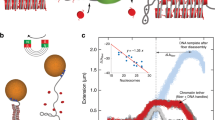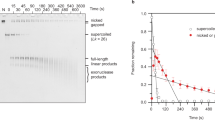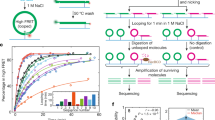Abstract
In cells, DNA is constantly twisted, bent and stretched by numerous proteins mediating genome transactions. Understanding these essential biological processes requires in-depth knowledge of how DNA complies to mechanical stress. Two important physical features of DNA, helical structure and sequence, are not incorporated in current descriptions of DNA elasticity. Here we connect well-defined force–extension measurements with a new model for DNA elasticity: the twistable worm-like chain, in which DNA is considered a helical, elastic entity that complies to tension by extending and twisting. In addition, we reveal hitherto unnoticed stick–slip dynamics during DNA overstretching at ∼65 pN, caused by the loss of base-pairing interactions. An equilibrium thermodynamic model solely based on DNA sequence and elasticity is presented, which captures the full complexity of this transition. These results offer deep quantitative insight in the physical properties of DNA and present a new standard description of DNA mechanics.
This is a preview of subscription content, access via your institution
Access options
Subscribe to this journal
Receive 12 print issues and online access
$209.00 per year
only $17.42 per issue
Buy this article
- Purchase on Springer Link
- Instant access to full article PDF
Prices may be subject to local taxes which are calculated during checkout




Similar content being viewed by others
References
Odijk, T. Stiff chains and filaments under tension. Macromolecules 28, 7016–7018 (1995).
Wang, M. D., Yin, H., Landick, R., Gelles, J. & Block, S. M. Stretching DNA with optical tweezers. Biophys. J. 72, 1335–1346 (1997).
Smith, S. B., Cui, Y. & Bustamante, C. Overstretching B-DNA: The elastic response of individual double-stranded and single-stranded DNA molecules. Science 271, 795–799 (1996).
Marko, J. F. & Siggia, E. D. Stretching DNA. Macromolecules 28, 8759–8770 (1995).
Gore, J. et al. DNA overwinds when stretched. Nature 442, 836–839 (2006).
Cluzel, P. et al. DNA: An extensible molecule. Science 271, 792–794 (1996).
Léger, J. F. et al. Structural transitions of a twisted and stretched DNA molecule. Phys. Rev. Lett. 83, 1066–1069 (1999).
Wenner, J. R., Williams, M. C., Rouzina, I. & Bloomfield, V. A. Salt dependence of the elasticity and overstretching transition of single DNA molecules. Biophys. J. 82, 3160–3169 (2002).
Williams, M. C., Wenner, J. R., Rouzina, I. & Bloomfield, V. A. Entropy and heat capacity of DNA melting from temperature dependence of single molecule stretching. Biophys. J. 80, 1932–1939 (2001).
Shokri, L., McCauley, M. J., Rouzina, I. & Williams, M. C. DNA overstretching in the presence of glyoxal: Structural evidence of force-induced DNA melting. Biophys. J. 95, 1248–1255 (2008).
van Mameren, J. et al. Unraveling the structure of DNA during overstretching by using multicolor, single-molecule fluorescence imaging. Proc. Natl Acad. Sci. USA 106, 18231–18236 (2009).
Gross, P., Farge, G., Peterman, E. J. G. & Wuite, G. J. L. Combining optical tweezers, single-molecule fluorescence microscopy, and microfuidics for studies of DNA-protein interactions. Methods Enzymol. 475, 427–453 (2010).
Marko, J. F. Stretching must twist DNA. Europhys. Lett. 38, 183–188 (1997).
Kamien, R. D., Lubensky, T. C., Nelson, P. & Ohern, C. S. Direct determination of DNA twist–stretch coupling. Europhys. Lett. 38, 237–242 (1997).
Marko, J. F. DNA under high tension: Overstretching, undertwisting, and relaxation dynamics. Phys. Rev. E 57, 2134–2149 (1998).
Bryant, Z. et al. Structural transitions and elasticity from torque measurements on DNA. Nature 424, 338–341 (2003).
Sheinin, M. Y. & Wang, M. D. Twist–stretch coupling and phase transition during DNA supercoiling. Phys. Chem. Chem. Phys. 11, 4800–4803 (2009).
Lionnet, T., Joubaud, S., Lavery, R., Bensimon, D. & Croquette, V. Wringing out DNA. Phys. Rev. Lett. 96, 1781021–1781024 (2006).
Essevaz-Roulet, B., Bockelmann, U. & Heslot, F. Mechanical separation of the complementary strands of DNA. Proc. Natl Acad. Sci. USA 94, 11935–11940 (1997).
Bockelmann, U., Essevaz-Roulet, B. & Heslot, F. Molecular stick–slip motion revealed by opening DNA with piconewton forces. Phys. Rev. Lett. 79, 4489–4492 (1997).
Bockelmann, U., Thomen, P., Essevaz-Roulet, B., Viasnoff, V. & Heslot, F. Unzipping DNA with optical tweezers: High sequence sensitivity and force flips. Biophys. J. 82, 1537–1553 (2002).
Rouzina, I. & Bloomfield, V. A. Force-induced melting of the DNA double helix-1. Thermodynamic analysis. Biophys. J. 80, 882–893 (2001).
Liphardt, J., Onoa, B., Smith, S. B., Tinoco, I. & Bustamante, C. Reversible unfolding of single RNA molecules by mechanical force. Science 292, 733–737 (2001).
Woodside, M. T. et al. Nanomechanical measurements of the sequence-dependent folding landscapes of single nucleic acid hairpins. Proc. Natl Acad. Sci. USA 103, 6190–6195 (2006).
SantaLucia, J. A unified view of polymer, dumbbell, and oligonucleotide DNA nearest-neighbour thermodynamics. Proc. Natl Acad. Sci. USA 95, 1460–1465 (1998).
Landau, L. & Lifshitz, E. Statistical Physics 3rd edn Vol. 5, Part 1 (Butterworth-Heinemann, 1980).
Albrecht, C. H., Neuert, G., Lugmaier, R. A. & Gaub, H. E. Molecular force balance measurements reveal that double-stranded DNA unbinds under force in rate-dependent pathways. Biophys. J. 94, 4766–4774 (2008).
Clausen-Schaumann, H., Rief, M., Tolksdorf, C. & Gaub, H. E. Mechanical stability of single DNA molecules. Biophys. J. 78, 1997–2007 (2000).
Calderon, C. P., Chen, W. H., Lin, K. J., Harris, N. C. & Kiang, C. H. Quantifying DNA melting transitions using single-molecule force spectroscopy. J. Phys. Condens. Matter 21, 034114 (2009).
Paik, D. H. & Perkins, T. T. Overstretching DNA at 65 pN does not require peeling from free ends or nicks. J. Am. Chem. Soc. 133, 3219–3221 (2011).
Zuker, M. Mfold web server for nucleic acid folding and hybridization prediction. Nucleic Acids Res. 31, 3406–3415 (2003).
Nollmann, M. et al. Multiple modes of Escherichia coli DNA gyrase activity revealed by force and torque. Nat. Struct. Mol. Biol. 14, 264–271 (2007).
Hall, M. A. et al. High-resolution dynamic mapping of histone-DNA interactions in a nucleosome. Nat. Struct. Mol. Biol. 16, 124–129 (2009).
Revyakin, A., Revyakin, A., Ebright, R. H. & Strick, T. R. Abortive initiation and productive initiation by RNA polymerase involve DNA scrunching. Science 314, 1139–1143 (2006).
McCauley, M. J. & Williams, M. C. Review: Optical tweezers experiments resolve distinct modes of DNA-protein binding. Biopolymers 91, 265–282 (2009).
Hegner, M., Smith, S. B. & Bustamante, C. Polymerization and mechanical properties of single RecA-DNA filaments. Proc. Natl Acad. Sci. USA 96, 10109–10114 (1999).
Baumann, C. G., Smith, S. B., Bloomfield, V. A. & Bustamante, C. Ionic effects on the elasticity of single DNA molecules. Proc. Natl Acad. Sci. USA 94, 6185–6190 (1997).
Bustamante, C., Marko, J. F., Siggia, E. D. & Smith, S. Entropic elasticity of lambda-phage DNA. Science 265, 1599–1600 (1994).
Acknowledgements
We thank J. Gore for communicating his experimental data. We thank M. Depken and C. Broederz for discussions. We thank M. Modesti for the kind gift of the eGFP labelled RPA. This work is part of the research program of the ‘Stichting voor Fundamenteel Onderzoek der Materie (FOM)’, which is financially supported by the ‘Nederlandse Organisatie voor Wetenschappelijk Onderzoek (NWO)’ (N.L., E.J.G.P., G.J.L.W.). P.G. is supported by ATLAS, a European Commission-funded Marie Curie early stage training network. G.J.L.W. is recipient of a VICI grant from the ‘Nederlandse Organisatie voor Wetenschappelijk Onderzoek (NWO)’. U.B. was supported by a KNAW visiting professor grant.
Author information
Authors and Affiliations
Contributions
P.G. performed experiments, the DNA unwinding modelling and analysis. N.L. performed the DNA unwinding analysis. L.B.O. assisted in the design of the study. U.B. developed the thermodynamical model for DNA unpeeling and assisted in the design of the study. E.J.G.P. and G.J.L.W. designed the study and assisted with the analysis. All the authors contributed to the writing of the paper.
Corresponding authors
Ethics declarations
Competing interests
The authors declare no competing financial interests.
Supplementary information
Supplementary Information
Supplementary Information (PDF 881 kb)
Rights and permissions
About this article
Cite this article
Gross, P., Laurens, N., Oddershede, L. et al. Quantifying how DNA stretches, melts and changes twist under tension. Nature Phys 7, 731–736 (2011). https://doi.org/10.1038/nphys2002
Received:
Accepted:
Published:
Issue Date:
DOI: https://doi.org/10.1038/nphys2002
This article is cited by
-
Coordinated motion of molecular motors on DNA chains with branch topology
Acta Mechanica Sinica (2022)
-
Coordinated motion of molecular motors on DNA chains with branch topology
Acta Mechanica Sinica (2021)
-
Anomalous Laterally Stressed Kinetically Trapped DNA Surface Conformations
Nano-Micro Letters (2021)
-
3D control stretched length of lambda-phage WLC DNA molecule by nonlinear optical tweezers
Optical and Quantum Electronics (2020)
-
Polarization induced control of optical trap potentials in binary liquids
Scientific Reports (2019)



